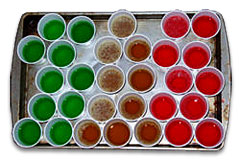Greetings,
A very important discussion among my colleagues this week: is it better to purchase reusable, petroleum-based products (plastic) or to use paper disposables? Specifically, we’re talking about Jell-O shot cups. A recent (and brilliant) invention is this little plastic shot cup with a twistable ring inside. Ostensibly, a flick of the wrist will free even the most stubborn Jell-O shot and allow hours of fun. Some of my friends have argued that the traditional sucking method is more green (and more fun) because the paper Dixie cups are renewable, unlike plastic. But the plastic ones can be reused time and time again for birthdays, weddings, bar mitzvahs, even Sunday brunch. Assuming you don’t mind a little horse hoof with your vodka, which shooting method is more green?
Andrew
Santa Barbara, Calif.
Editor’s Note: Oh, how Umbra would love to answer this question — but she’s been kidnapped! Please donate to Grist by 11:59 p.m. Pacific on Dec. 11, 2007, to secure her safety. The sooner we see 2,000 gifts of any size (yes, even $1!), the sooner you’ll get the great green advice you’ve come to know and love.
Editor’s update: Umbra has been released, thanks to your generosity, and was able to pen an answer to this query.
Dearest Andrew,
If, unlike my captors, you are committed to reusing your plastic cups and tableware, then go forth and purchase these novelty Jell-O cups. We have oft referred to Ilea’s summary of cup lifecycle analyses; in this instance we can loosely compare your Jell-O cup choice to a coffee cup choice. Broadly speaking (because the study did not, of course, compare your very specific cups), you will need to use your plastic novelty cups at least 17 times before they are better than a paper cup. I just wonder if you will actually reuse them, or if you — and other Jell-O shotters — are going to be too hung over to want to bother.

Plus, I have some news for you: gelatin does not usually contain horse hooves. Nope. Instead, it’s usually the boiled-down hides and bones of pigs and cows. Is this better than, worse than, or equally as bad as horse hooves? Only you can decide. Gelatin is a slaughter byproduct, full of history and tradition: Rose Knox became a path-breaking female industrialist when she took over Knox Gelatin in 1908. Vegetarian drinkers can make their own ersatz shots-shots with agar-agar, which would then properly be called “kanten shots.”
Do not drink and drive, and don’t eat too many of those alcohol-filled slaughter remnants. Think of your liver.
Collagenly,
Umbra

